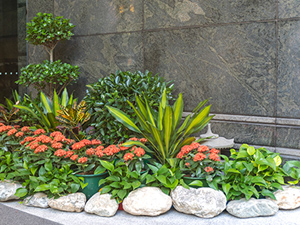Dimension stone panels are vertically placed, non load-bearing stone slabs, found as an ornamental facing on both building exteriors and interiors, in both new construction and renovation projects. Dimension stone panels are a popular design choices for business centers, corporate headquarters, hotels, educational facilities, hospitals, libraries, government buildings, embassies, airports, churches, and high-end residential properties.
Dimension Stone Panel Pros
Dimension stone panels protect and insulate, but their main purpose is to convey a sense of permanence, stability, and beauty. Because natural stone is a non-manufactured product, it is a very unique and enviable surface material for panels with character. Architects and designers have a wide variety of options with dimension stone, because each slab has its own unique color, grain, veining, and other features. There are also a wide variety of stone finishes include polished, honed, sand blasted, leathered, flamed, and more. Edge options are just as numerous, including straight, smooth, rough split, chiseled, beveled, etc. With proper anchoring, most dimension stone is appropriate for interior panels.
Dimension Stone Panel Cons
Special considerations for stone selection for exterior applications include positive and negative pressure from wind, structural settling and concrete contraction (in new construction), freeze and thaw cycles, porosity, and other factors. Problems may include cracking, staining, or even complete failure. One of the most common causes of external panel failure is thermal hysteresis, where the sun heats the outer layer of stone at a greater degree than the back side. Over time, the stone bows, not only losing its aesthetic appeal, but also posing a dangerous risk if the panels were to fall off. Once a stone panel is bowed, it cannot be restored, and replacement is the only option.
Dimension Stone Panel Alternatives
Modern, lightweight stone panels offer the desirable benefits of dimension stone without as many limitations and challenges. This innovative surface material is comprised of a thin layer of stone reinforced by a fiberglass or aluminum honeycomb backing. Bowing is not as much of an issue, because the temperature of the thin stone layer remains more constant throughout, plus the backing material absorbs building stresses that would normally result in damage of dimension stone panels.
Another alternative to dimension stone panels is large-format manufactured porcelain, which can either mimic the look of natural stone very closely or have an entirely different look for more design possibilities. Like lightweight stone panels, porcelain can be reinforced by a honeycomb backing, and in some cases, with the proper adhesives, can be installed directly to the wall surface. Porcelain panels have a larger size potential than lightweight stone panels, as well.
Reputable, qualified fabricators can counsel architects and designers about what types of dimension stone, lightweight stone, or porcelain panels are feasible and most conducive to a successful, lasting installation.
This is one of a series of articles written and published on behalf of Surface Care PRO Partners.

